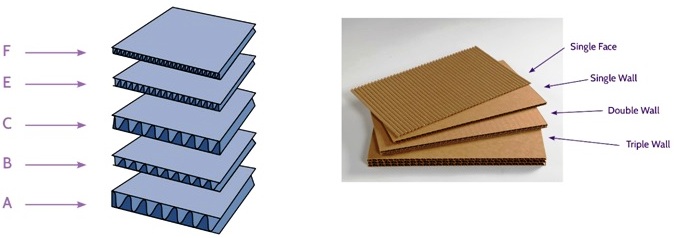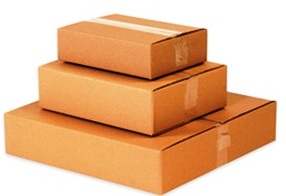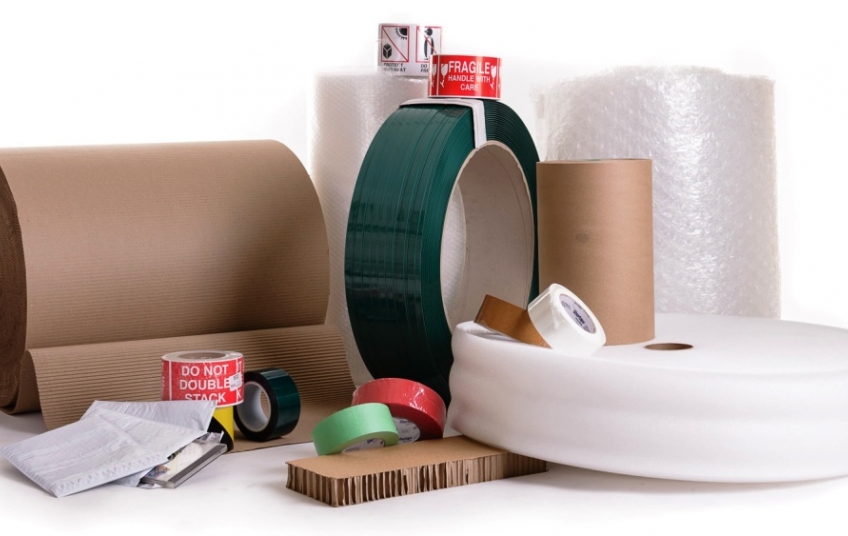Whether or not we realize it, almost every item that we use in our day to day lives comes in some sort of package. Usually when we see the packaging, we think that it serves just to protect our product, but it does much more than that. Packaging is the wrapping material around a consumer item that serves to contain, identify, describe, protect, display, promote and otherwise make the product marketable and keep it clean (Entrepreneur.com). Packaging can come in a variety of forms and materials, even for the same category of product. Some of the most commonly used materials are corrugated fiberboard, glass, plastic, and aluminum.
Corrugated Fiberboard, according to the Fibre Box Association, has two main components. One component is the Linerboard, which is a flat material that clings to the medium and can be on the outside or inside of the structure. The other component, the Medium, is the paper that is formed into flutes and then placed in between the linerboard facings. The flutes play a key role in this type of material because they resist bending and pressure from different directions, providing more strength to the package. They act to keep the linerboard sheets separated, which creates a cushioning effect for the container’s contents when pressure is applied to the side of the board. But it isn’t a one-way effect, while the flutes protect the linerboard, the vertical linerboard protects the flutes from damage. Flutes can come in a variety of designs, sizes, and numbers; and each combination can provide superior strength. The flutes that are mainly used range from A to E, with the exception of a D flute; and the structures that they create are: triple wall, double wall, single wall, and single face. Each flute has an area that its design favorably caters to. For instance, smaller flutes are used in primary packaging due to their structural capabilities.

When it comes to the design of the actual box, combining layers of corrugated or adding interior packaging will allow the box to hold or transport almost any product effectively. So, the boxes can be custom made or, like the flutes, there are a variety of standard options that can be chosen. Names for frequently used boxes are: folders, self-erecting boxes, slotted boxes, interior forms, rigid boxes, and telescope boxes. Corrugated Fiberboard makes packaging very easy, but there are also downsides when it comes to this material. Things like stacking can cause boxes to wear and tear due to the weight that is pressing down upon each other. Its important to be cautious when handling boxes because too much force can penetrate the packaging and go straight through to the product.

Glass packaging, even though it seems like it wouldn’t be that common, is used on things that we come in contact with every day: beverages, medicine, and food. These products are what we digest, so the packaging that they come in needs to be something that is safe and sterile enough to hold them. Glass fits the criteria because it is made from raw materials like limestone, sand, and soda ash; and it also keep the product fresh by keeping oxygen and excess moisture out of the packaging. Glass is so strong due to the tampering and laminating processes. Laminating is the process of adding a plastic layer over the glass and tampering is when the glass is heated and the surface cools faster than the rest of the material. These processes are used to increase the strength of glass surface so that the glass won’t be prone to breaking while the product is inside. But even though the glass itself is strong, it still has some disadvantages associated with its packaging. For one, it is very fragile; if something were to happen and the consumer broke the packaging, it would lead to the spoilage and waste of what they wanted, the product. Not to mention the safety concerns associated with the bits and pieces of the shattered glass. One thing that has a huge factor in the material being broken is the weight of it, people underestimate how heavy it can be, especially when they go based off of the size of the package.

Plastic has an endless amount of ways it is used in our everyday lives, but when it comes to a product, packaging is where we come in contact with it the most. Plastic packaging displays information, prevents waste, and preserves and protects the product. One way it preserves our products is by keeping food from spoiling. This may not seem like a big deal, but food spoilage plays a large role in our carbon footprint due to the large number of resources that go into producing our food. Things like powders, gels, liquids, and out-of-season fruit especially, are constantly being shipped around the globe; and the amount of time that they spend in trucks and other carriers, show that extra care must be taken to make sure that those shipments don’t add on to the global problem.
Plastic is ideal for packaging because it has characteristics that can go with any type of product. For one, it is physically safe. Plastic doesn’t break when it is dropped, so any package that is made with it can rely on the fact that the protective layer will remain intact. It is also versatile, it can be thermomoulded, injected, or blown. This means that a product will have added security during the transportation process due to the package being molded to fit the product. Plastic is also hygienic, which plays a huge factor when it comes to food and medical device packaging. Medical devices go through a number of cycles to keep the product sterile before putting it into a molded package, so the package needs to be able to shield the product from any bacteria that would come in contact with the device. Not only that, the package also needs to be able to last as long as the product does, if the lifespan of a product is eight years, then the product needs to resist any penetration or contamination for that time as well. Although plastic may be ideal for packaging, that still doesn’t turn us away from the disadvantages of it. The biggest disadvantage is that it is damaging the planet. Plastic is hard to break down, so when it comes to disposal and waste, it is being spread all over the Earth and stays there. Because it ends up in many environments full of animals, the animals come in contact with it thinking that it is food, and then end up choking or strangled.

Aluminum Packaging is most commonly seen with beverage/food cans and in blister packaging. Aluminum is one of the better choices for this because it is able to slow down the growth of bacteria due to the high temperature it is put under during the annealing process. This is key during transporting because packages need a material that will be able to withstand all the different factors that the package will come in contact with. Another reason that a product is able to withstand different environments is because aluminum is very durable. It is so durable that even thin sheets of it provide the right protection to keep the product lasting for multiple days or even months. Strength isn’t the only benefit that aluminum provides, it is also extremely easy to manipulate to a desired shape and design. This makes it convenient for businesses who want to give their product a specific look while still keeping it protected and secured. It would seem like all the shaping and forming would weaken the strength of the aluminum, but it does no harm to the barrier integrity. The aluminum does have its disadvantages though, one of those being that certain products don’t chemically mix well with the material. Certain foods, if placed in an aluminum can, will react negatively to it due to their acidic nature.

References
“Aluminum in Packaging.” The Future Protects With Aluminum, packaging.world-aluminium.org/home/.
“Corrugated Boxes.” Corrugated Boxes | Shipping Boxes | Cardboard Boxes for Shipping, Moving and Storage | ShippingSupply.com, www.shippingsupply.com/c-1-corrugated-boxes.aspx.
“Different Types of Packaging Materials.” Commercial Packaging for Industry, www.iwkapacsystems.com/different-types-of-packaging-materials.
“Glass Information & Properties.” SKS Bottle & Packaging - Glass Bottles, Plastic Bottles, Glass Jars, Metal Tins and More, www.sks-bottle.com/Glass_Info.html.
“Packaging Types for Glass.” Electrical Engineer (En-Us) | Optima, www.optima-packaging.com/en-us/consumer/solutions-for/glass?msclkid=01c8f4ea18e518d58666af4c306db8c2&utm_source=bing&utm_medium=cpc&utm_campaign=EN-US%2B-%2BDYN&utm_term=%2Fen-us%2Fconsumer&utm_content=Consumer.
Patel, Deep, and Doe Deere. “Packaging Definition - Entrepreneur Small Business Encyclopedia.” Entrepreneur, Entrepreneur, www.entrepreneur.com/encyclopedia/packaging.
Schoo, Rowena. “Why Do We Need Plastic Packaging?” Polyethylene (High Density) HDPE, British Plastics Federation, 17 Feb. 2017, www.bpf.co.uk/packaging/why-do-we-need-plastic-packaging.aspx
“Thermoformed Plastic Packaging, Retail Clamshells, Custom Trays.” Placon, www.placon.com/about/.
www.RadiaInteractive.com, Development by. “What Is Corrugated?” What Is Corrugated? - Detailed Information on Common Board Styles and Flutes, www.fibrebox.org/info/whatiscorrugated.aspx.


































